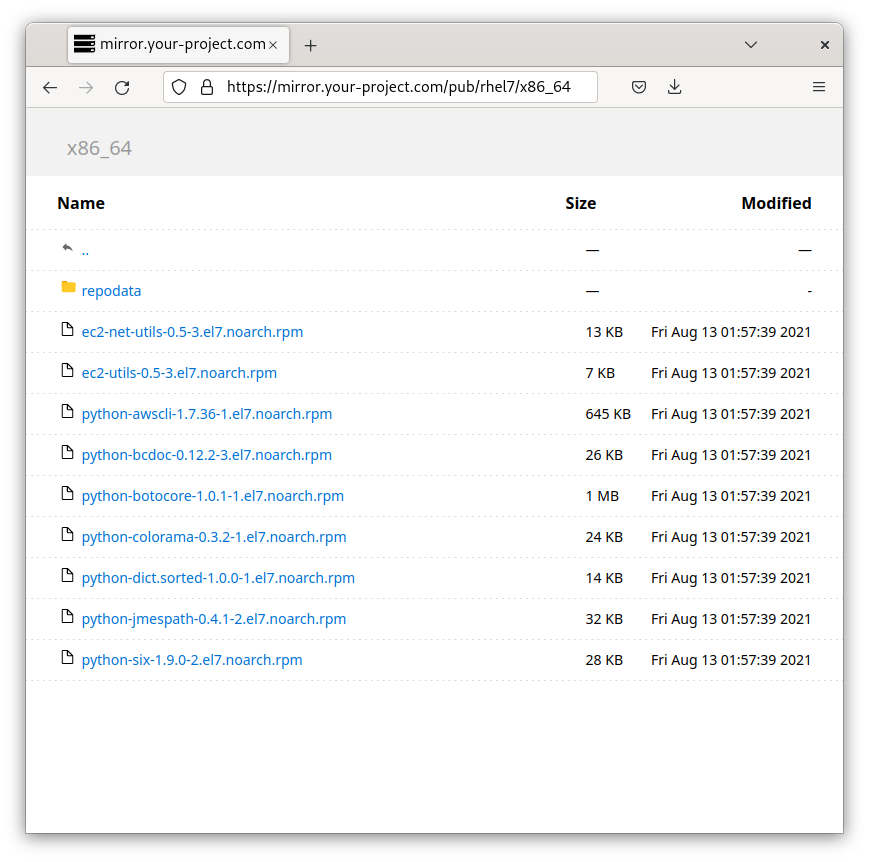Want to turn your AWS S3 bucket into a highly scalable, easy to web browse, file server? This project does just that with no operational overhead (i.e. no servers to manage).
It's a common problem:
- You have an S3 bucket and want to host files from it. Easy!
- You want your users to be able to navigate the directory structure in a web browser and download files, similar to a traditional "Apache Directory Listing". Harder!
Benefits of this project's approach:
- Completely serverless.
- Simple / static client browser content:
- No Ajax or third party libraries to worry about.
- No browser compatibility worries.
- All backing systems are native AWS components.
- You never share credentials or rely on 3rd party services.
- The S3 bucket remains private - allowing you to only expose parts of the bucket.
- A custom hostname / SSL certificate can be established (e.g. https://files.yourproject.com/).
- Some or all of the host files can be protected behind Basic Auth username/password.
- An AWS WebACL can be configured to prevent abusive access to the service.
- Create the CloudFormation stack by uploading dist/aws-s3-browser-file-listing.cf.yaml. The parameter to this formation is the name of the S3 bucket to create.
- Create several new files in the resulting new S3 bucket (or copy the content of s3-bucket-bootstrap) into the root of the bucket:
favicon.ico(root of s3) to act as the web browser icon for the file server.404.html(root of s3) to provide the user 404 / file not found webpage content (see resulting distribution "Error Pages" configuration).- Upload at least file with the prefix
pub/. For example, '/pub/README'. With this project, a "directory" will not exist until it contains a file.
- Enter the domain of the distribution into your web browser (see DistributionDomain in output).
- Optional. If you wish to set up basic auth for non-pub/ content, create an AWS Secrets Manager secret with the name
${S3Bucket}-basic-auth/accountswhere${S3Bucket}is the name of the backing S3 bucket created for the deployment. Keys are usernames and passwords are values.
Q: How can I set up a custom domain name? A: Configure the CloudFront distribution with a custom domain & certificate.
Q: How do I set MIME types for my files?
A: Set the content-type when uploading content to S3
Q: How do I prevent CloudFront from caching certain directories / file types?
A: Create a new behavior for the distribution which matches a pattern (e.g. */repomd.xml). Exactly duplicate the lambdas used in the default behavior but disable all caching.
Q: I get an error when I try to access a directory or file that is not present. How do I make that a friendly message? A: Populate a 404.html in the root of the S3 bucket. This is configured in the "Error Pages" configuration of the CloudFront distribution.
Q: How do I set up username/password based authentication for certain areas of the file server?
A: Anything under pub/ in the S3 bucket will be accessible without authentication. If you want to establish, for example, private/ in the S3 bucket, the lambda will require a basic auth header from the user. To establish valid usernames & passwords, populate a new secret (type 'other') in AWS Secrets Manager with the name ${S3Bucket}-basic-auth/accounts where ${S3Bucket} is the name of the backing S3 bucket created for the deployment.
Q: How can I change the styling of the directory listing?
A: The HTML/CSS is inlined within src/s3-get-index-html-gen-lambda.py. Update the content and run ./build.py in the root of the repo. dist/aws-s3-browser-file-listing.cf.yaml will be updated with the result.
Q: How can I modify the behaviors in my CloudFront distribution via CloudFormations?
A: src/aws-s3-browser-file-listing.cf-template.yaml serves as the basis for the CloudFormation template. Update it and run ./build.py in the root of the repo. dist/aws-s3-browser-file-listing.cf.yaml will be updated with the result.
In short, this project uses Lambda@Edge scripts, configured as AWS CloudFront Event functions, to render and return an HTML-based directory listings back to a client web browser.
Browsing a directory:
- A client makes a request to the CloudFront domain. In this example, we will use
xxxxxxxxxxxx.cloudfront.net/pub/. - A behavior is configured in the CloudFront deployment to run a Lambda@Edge function each time a URL with path
*/is requested (i.e. a directory vs a filename).pub/matches this pattern and the Lambda@Edge will be synchronously invoked to handle the incoming request. - The Lambda function will query the backing S3 bucket to determine the contents of the "directory" (actually an S3 prefix since S3 does not have a directory hierarchy).
- Objects with the prefix and "sub-directories" of the prefix are used to dynamically generate an HTML file (the file listing).
- The HTML is returned to the client and the user receives a visualization of the files / sub-directories in the directory they are browsing.
Downloading a file:
- A client makes a request to the CloudFront domain. In this example, we will use
xxxxxxxxxxxx.cloudfront.net/pub/README. - The URL path does not match the directory listing behavior (
*/) and the request passes straight through to CloudFront which serves the file from S3 or its caches.
- Using dynamic JavaScript to query public bucket APIs: https://github.com/qoomon/aws-s3-bucket-browser .
- Using a paid service (or one which uses a running server). e.g. https://www.filestash.app .
Thanks to github.com/glowinthedark for their work on statically generating index HTML files from local directory structures. This project served as the starting point for the index generation from S3.
